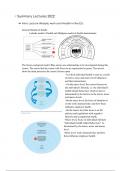⇨ Summary Lectures 2022:
➔ Intro Lecture lifestyle, work and Health in the EU:
General Models of health:
- Lalonde model of health and Dahlgren model of health determinants:
The Socio-ecological model. Blue arrows are relationships to be investigated during this
course. The issues that the course will focus on are represented in green. The arrows
show the main processes the course focuses upon.
- In which individual health is seen as a result
of micro, meso and macro level influences
and their interactions.
- On the micro level, the course focuses on
the individual’s lifestyle, i.e. the individual's
health related behaviour, which in turn is
determined by the factors on the micro, meso
and macro levels.
-On the meso level, the focus of attention is
on the work characteristics and how these
influence employee health.
-On the macro level the focus is on EU
policies and regulations with regard to
lifestyle and occupational health.
- Micro level, focus on individuals lifestyle
“individuals health related behaviour”. Is
determined by the micro, meso and macro
level.
-Meso level: work characteristics and how
these influence employee health
, - Macro level: EU policies and regulations with regard to lifestyle and
occupational health
More about the Socioecological model:
- Work characteristics can affect individual health directly (arrow 1, such as
dangerous or stressful working situations, unhealthy effects of shift work) and
indirectly through lifestyle (arrows 2 and 3, e.g. shift work leading to an
unhealthy lifestyle). Work characteristics are strongly intertwined with the
worker’s socio-economic position (SEP), working conditions tend to be
dependent on the educational level and cultural background of the worker.
- Interaction between the socio-economic position, work characteristics and
lifestyle, and how this contributes to socio-economic inequalities in health.
- On the micro level, how individual behaviour can be changed to a healthier
lifestyle.
- On the meso level, it is addressed how work characteristics can be improved in
order to make employees healthier and sustainably employable, and how the work
site setting can be used for promoting a healthy lifestyle.
- On a macro level, it is discussed how EU policies and regulations on lifestyle and
occupational health can lead to more health and well-being, by leading to a
healthier work characteristics (arrow 4) and a healthier lifestyle (arrow 5)
- Somebody’s socio-economic position determines partly the characteristics of the
work one has, in turn the work determines one’s income and therewith the
lifestyle and housing one can afford.
- The extent of differences in socio-economic position in a society are strongly
dependent on macro-social and political circumstances: minimum wages,
income-dependent tax rates and social housing are all matters of politics.
- This course focuses on the determinants of INDIVIDUAL HEALTH on the
micro, meso and macro level.
Overview of cases:
- Cases 1 and 2 are about the micro level, behaviors relevant for health, why people
behave in a healthy or unhealthy way.
- Case 3, 4,5,7 further address the meso level. Study what the effects of work
characteristics are on individual health. How the work setting can be used to
change lifestyle and work-related habits.
- Case 6 wrap up case.
- Cases 8,9,10 are the macro level. Focus on EU regulations
- Understand how the determinants of different levels (micro, meso and macro
interact)
,➔ Lifestyle, Environment and the EU:
Contextualising and Defining lifestyle:
- Defining lifestyle as the way we live and the choices, actions that one has the
ability to influence one's own life.
- Definition of lifestyle: lifestyle is a term used to describe behaviors that emerge
through a complex interrelationship among voluntary, biological, and
environmentally-induced factors.
History of focusing on lifestyle in health:
- Focus on lifestyle is arguably the oldest approach to public health
- This focus was partially eclipsed by the “3 A’s in medicine 1850-1940” -
antisepsis, anesthesia, antibiotics.
(Antisepsis is the practice of eliminating microorganisms that cause the disease)
- The focus (re-) emerged after the 2nd world war as an indispensable component
of public health work.
- This is where modern history of lifestyle begins
Lalonde report (1974): conceptualization of health upon these 4 determinants:
Four macro-determinants
- Professional care
- Genetics
- Behavior
- Environment
Alma Ata Declaration (1978):
- Many people came together and talked about what has to be done after
conceptualizing health. What health strategies match the determinants of the
lalonde report
- Major result is the return to primary care medicine and to combine lifestyle
oriented health with education.
Main components of the Alma Ata declaration:
1. Health for all
2. Primary health care
3. Health a fundamental human right
4. Equity
5. Appropriate technology
6. Inter-sectoral development: an important concept that has come up to develop health
within many sectors.
7. Community participation
, Blum model (1983): touches upon the same
determinants of the lalonde model:
conceptualization of health in the 4
determinants:
- Heredity - Genetics
- Lifestyles
- Medical care services
- Environment
Ottawa charter for health promotion (1988):
moment of when the health promotion has
started: health promotion as a field of
professional activity:
- People came together to refine strategies 10
years after the alma ata, they kept the charter
simple with the core being enabling, mediating
and advocating for health.
1. Enabling people: by providing people with
resources to achieve health
2. Mediating: mediating effect between those who
are in health needs and those who have access
(population)
3. Advocating: bringing things from populations
to those in power, explaining policies and rights to
lay people. Then comes Focusing on environments
and developing health skills in the model.
Dahlgren and White head (1991):
- The role of the society and environment on health
- However it is broad and does not specify which
environments affect health
- The rise of holistic thinking of health determinants





